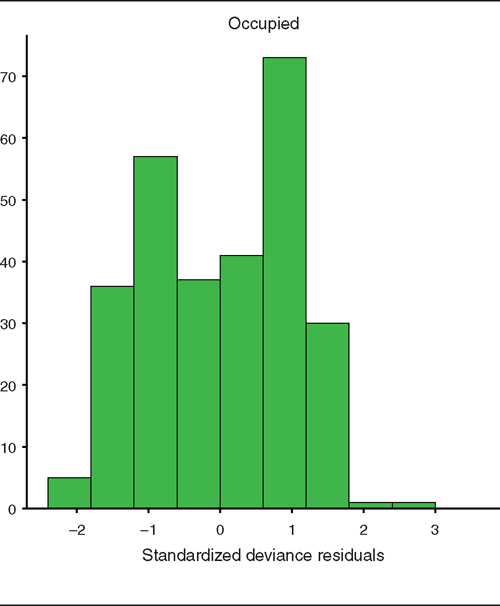The characteristics of den trees used by the squirrel glider (Petaurus norfolcensis) in temperate Australian woodlands
M. J. Crane A B C , R. M. Montague-Drake A , R. B. Cunningham A and D. B. Lindenmayer AA Fenner School of Environment and Society, Australian National University, Canberra, ACT 0200, Australia.
B 117 Sheridan Street, Gundagai, NSW 2722, Australia.
C Corresponding author. Email: masoncrane@yahoo.com
Wildlife Research 35(7) 663-675 https://doi.org/10.1071/WR07142
Submitted: 12 September 2007 Accepted: 15 July 2008 Published: 17 November 2008
Abstract
Being able to recognise critical habitat features such as nesting and denning sites is essential for wildlife conservation. It is particularly true for the den trees of species threatened by habitat loss, such as the squirrel glider (Petaurus norfolcensis). Measurements of 146 den trees of the squirrel glider were made in fragmented woodlands of the South-west Slopes of New South Wales and data compared with random trees to quantify the key characteristics of den sites. The likelihood of use as a den tree increased with increasing numbers of visible tree hollows and tree size. Dieback was also a positive indicator of den use. However, when visible hollows within a tree are abundant, dieback-free trees were preferred. Measures of den tree context such as basal area, the number of neighbouring large trees and distance to the next nearest tree, were also found to be important determinants of the likelihood of usage. The above variables were combined into a multiple regression model. The squirrel glider favoured particular Eucalyptus species and some broader eucalypt groups. We believe such variations were most likely due to interspecific differences in hollow development and dieback among the various groups, rather than bark type, a factor previously cited as an important determinant of den tree usage. The ‘best’ model had high negative predictive power, suggesting it would be useful for identifying (1) trees that could be felled without a loss of this critical habitat resource (e.g. at development sites) and (2) areas unsuitable for potential squirrel glider relocation or habitat enhancement. Squirrel gliders show preference for a combination of tree and tree context features in selecting den trees. Understanding these features will help managers enhance and protect denning resources for this species.
Acknowledgements
We thank the Hume and Wagga Wagga Rural Lands Protection Boards, Wagga Wagga City and Greater Hume Shire Councils (formerly Culcairn Shire Council), Peter Webb, and Ian and Pam Parson for allowing us access to their properties. A special thanks to Cody Keys for his assistance with trapping and radio-tracking and also Damian Micheal, Chris MacGregor, Ben MacDonald, Nicki Munro, and Jake Gillen. Thanks to our two wildlife veterinarians Karen Viggers and Arianne Lowe. Trapping and radio-tracking were conducted under the Australian National University Animal Experimentation Ethics Committee (AEC no. C.RE.39.05).
Allouche, O. , Tsoar, A. , and Kadmon, R. (2006). Assessing the accuracy of species distribution models: prevalence, kappa and the true skill statistic (TSS). Journal of Applied Ecology 43, 1223–1232.
| Crossref | GoogleScholarGoogle Scholar |
Bennett, A. F. , Lumsden, L. F. , and Nicholls, A. O. (1994). Tree hollows as a resource for wildlife in remnant woodlands: spatial and temporal patterns across the northern plains of Victoria, Australia. Pacific Conservation Biology 1, 222–235.
Cowan, P. E. (1989). Denning habitats of the common brushtail possums, Trichosurus vulpecula, in New Zealand lowland forest. Australian Wildlife Research 16, 63–78.
| Crossref | GoogleScholarGoogle Scholar |
Harper, M. J. , McCathy, M. A. , van der Ree, R. , and Fox, J. C. (2004). Overcoming bias in ground-based surveys of hollow-bearing trees using double sampling. Forest Ecology and Management 190, 291–300.
| Crossref | GoogleScholarGoogle Scholar |
Manel, S. , Williams, H. , and Ormerod, S. J. (2001). Evaluating presence–absence models in ecology: the need to account for prevalence. Journal of Applied Ecology 38, 921–931.
| Crossref | GoogleScholarGoogle Scholar |
McPherson, J. M. , Jetz, W. , and Rogers, D. J. (2004). The effects of species’ range sizes on the accuracy of distribution models: ecological phenomenon or statistical artefact? Journal of Applied Ecology 41, 811–823.
| Crossref | GoogleScholarGoogle Scholar |
Menkhorst, P. W. , Weavers, B. W. , and Alexander, J. S. A. (1988). Distribution, habitat and conservation status of the squirrel glider Petaurus norfolcensis (Petauridae: Masupialia) in Victoria. Australian Wildlife Research 15, 59–71.
| Crossref | GoogleScholarGoogle Scholar |
Rowston, C. (1998). Nest- and refuge-tree usage by squirrel gliders, Petaurus norfolcensis, in south-east Queensland. Wildlife Research 25, 157–164.
| Crossref | GoogleScholarGoogle Scholar |
Traill, B. J. , and Lill, A. (1997). Use of tree hollows by two sympatric gliding possums, the squirrel glider, Petaurus norfolcensis and the sugar glider, Petaurus breviceps. Australian Mammalogy 20, 79–88.
van der Ree, R. , Bennett, A. F. , and Soderquist, T. R. (2006). Nest-tree selection by the threatened brush-tailed phascogale (Phascogale tapoatafa) (Marsupialia: Dasyuridae) in a highly fragmented agricultural landscape. Wildlife Research 33, 113–119.
| Crossref | GoogleScholarGoogle Scholar |

Appendix 1

|
Appendix 2

|


